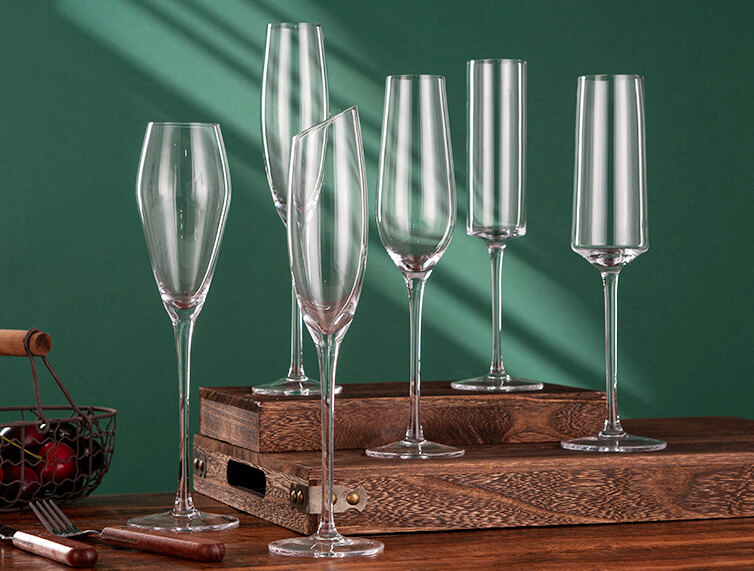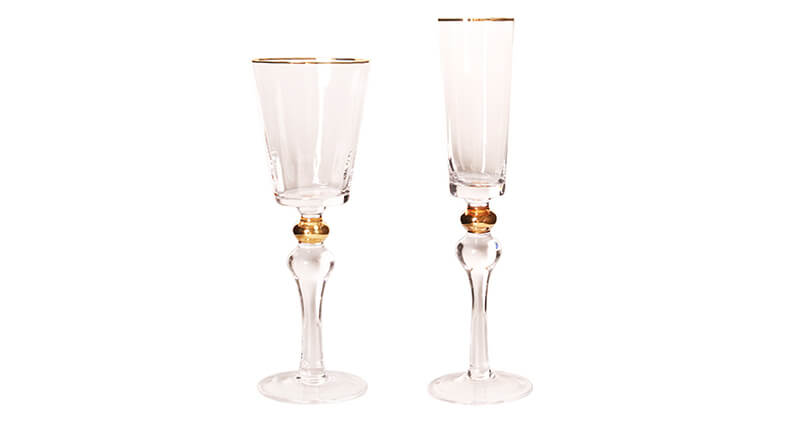Champagne, the epitome of celebration and sophistication, has captivated the world’s imagination for centuries. Beyond the allure of its golden bubbles lies a crucial, yet often overlooked aspect: the glass from which it is sipped. The right choice of glass can transform a simple act of drinking champagne into a memorable sensory experience, enhancing both its flavor and aroma.
Types of Champagne Glasses
The design of a champagne glass isn’t just about aesthetics; it plays a critical role in the sensory experience of drinking champagne. From the shape of the bowl to the width of the rim, each element can enhance or diminish the champagne’s aroma, flavor, and the vivacity of its bubbles. Below, we explore the main types of champagne glasses and what makes each of them special.
The Coupe
A Nod to the Past: The Coupe glass, with its broad bowl and shallow depth, harks back to a bygone era of glamour and excess. It allows the champagne to open up, releasing its aroma, but at the cost of quickly losing its bubbles. This glass is perfect for champagne-based cocktails or for those who prefer a less effervescent champagne experience.
The Flute
Elegance Personified: The Flute is perhaps the most recognizable and widely used champagne glass. Its tall, narrow shape keeps the bubbles lively and concentrated, pushing the aroma to your nose and enhancing the overall tasting experience. The Flute is ideal for pure, unadulterated appreciation of good champagne, focusing on preserving the integrity of its effervescence.
The Tulip
The Sensory Enhancer: Slightly wider in the middle than the Flute, the Tulip glass allows more room for the champagne’s aroma to develop, while its inward-curving top captures and concentrates the bouquet. This design is considered by many connoisseurs to be superior for tasting complex champagnes, as it balances the preservation of bubbles with the development of aromas.
The Stemless Glass
Modern and Versatile: Stemless champagne glasses offer a contemporary twist on traditional champagne drinking. They are practical, reducing the likelihood of spills and breakage, and can double as elegant cocktail or wine glasses. However, they may warm the champagne more quickly due to the hand’s direct contact with the bowl, which some purists argue could compromise the drinking experience.
Specialty Glasses
Unique Occasions Call for Unique Glasses: Beyond the main types, there are specialty glasses designed for specific champagnes or occasions. These can range from vintage glasses that add a touch of historical elegance to your table, to designer glasses that serve as a statement piece. While not necessary for enjoying champagne, they can add an extra layer of personalization and flair to special events.

Choosing the Right Glass
Selecting the ideal champagne glass is more than just a matter of aesthetics; it’s about enhancing your sensory experience. Here are key considerations to help you make the best choice:
Consider the Champagne Type
Vintage vs. Non-Vintage: Vintage champagnes, with their complex flavors and aroma profiles, are best enjoyed from a Tulip glass, which allows their nuances to fully develop. Non-vintage champagnes, often lighter and more straightforward, are well-suited to the crisp clarity of a Flute.
Rosé and Specialty Champagnes: These can benefit from the broader bowl of a Coupe or Tulip, allowing the unique flavors and aromas to breathe and express themselves more fully.
Think About the Occasion
Formal Events: A Flute or Tulip glass adds an element of elegance and sophistication, perfect for weddings, anniversaries, or any formal celebration.
Casual Gatherings: Stemless glasses or Coupes can lend a relaxed, modern vibe to your event, making them ideal for casual meetups or parties.
Personal Preference Matters
Ultimately, the choice of glass comes down to personal preference. Consider what aspects of champagne enjoyment matter most to you—preservation of bubbles, development of aromas, or perhaps the feel of the glass in your hand.
Conclusion
Choosing the right champagne glass is an essential part of the champagne-drinking experience. It’s not just about tradition or aesthetics; it’s about how the shape of the glass can enhance the taste, aroma, and overall enjoyment of your champagne.
From the elegance of the Flute to the sensory delight of the Tulip, each glass has its own story and its own way of bringing out the best in your champagne. Whether you’re celebrating a special occasion or simply enjoying a quiet moment of luxury, the right glass can make all the difference.

FAQ Section
When it comes to enjoying champagne, questions abound. Here, we answer some of the most common queries to help you refine your champagne experience.
Can I Use a Wine Glass for Champagne?
Versatility Meets Tradition: While champagne is traditionally served in specific glasses designed to enhance its characteristics, using a wine glass, especially a white wine glass, is not a faux pas. In fact, a wine glass can be a good alternative for enjoying champagne, particularly vintage varieties, as it allows the wine’s aroma and flavor profile to open up more fully than a narrow flute might.
How Many Types of Champagne Glasses Should I Own?
Building Your Collection: For most enthusiasts, having a set of Flutes and a set of Tulip glasses would cover a wide range of champagnes and occasions. Flutes are perfect for more formal events and for champagnes where preserving the effervescence is key. Tulip glasses are ideal for enjoying the complex aromas of vintage champagnes. Adding a few Coupes to your collection can also be great for casual entertaining and cocktails.
Does the Glass Really Make a Difference?
The Sensory Impact: Absolutely. The shape of the glass affects how the champagne interacts with the air and how the aromas are concentrated and delivered to your nose. It can also influence the longevity and behavior of the bubbles, which are an integral part of the champagne experience. Experimenting with different glasses can be a fun and enlightening way to discover what suits your palate best.
How Should I Clean and Store Champagne Glasses?
Care and Maintenance: Champagne glasses, especially those with thin rims and delicate stems, should be washed by hand in warm, soapy water and then rinsed thoroughly. Avoid using fabric that may leave lint. To dry, gently use a lint-free cloth or allow them to air dry upside down on a rack. Store them in a cabinet or a stemware rack with sufficient space to avoid crowding, which can lead to chips or breaks.
Is There a ‘Best’ Glass for Champagne?
Personal Preference Reigns Supreme: While different glasses can enhance various aspects of the champagne experience, there is no single “best” glass. The best glass for you depends on your personal preferences, the types of champagne you enjoy most, and how you like to enjoy them. Experimentation is key—try different glasses to find what enhances your champagne experience the most.


